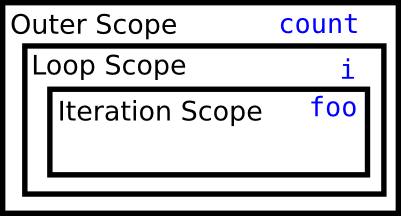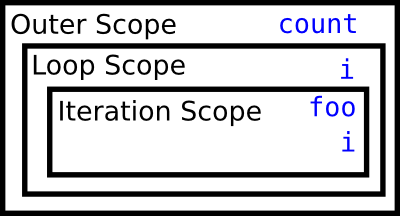nullprogram.com/blog/2014/06/06/
The April 5th, 2014 draft of the ECMA-262 6th Edition
specification — a.k.a the next major version of
JavaScript/ECMAScript — contained a subtle, though very significant,
change to the semantics of the for loop (13.6.3.3). Loop variables
are now fresh bindings for each iteration of the loop: a
per-iteration binding. Previously loop variables were established
once for the entire loop, a per-loop binding. The purpose is an
attempt to fix an old gotcha that effects many languages.
If you couldn’t already tell, this is going to be another language
lawyer post!
Backup to C
To try to explain what this all means this in plain English, let’s
step back a moment and discuss what a for loop really is. I can’t
find a source for this, but I’m pretty confident the three-part for
loop originated in K&R C.
for (INITIALIZATION; CONDITION; ITERATION) {
BODY;
}
- Evaluate INITIALIZATION.
- Evaluate CONDITION. If zero (false), exit the
for.
- Evaluate BODY.
- Evaluate ITERATION and go to 2.
In the original C, and all the way up to C89, no variable declarations
were allowed in the initialization expression. I can understand why:
there’s a subtle complication, though it’s harmless in C. We’ll get to
that soon. Here’s a typical C89 for loop.
int count = 10;
/* ... */
int i;
for (i = 0; i < count; i++) {
double foo;
/* ... */
}
The variable i is established independent of the loop, in the scope
outside the for loop, alongside count. This isn’t even a per-loop
binding. As far as the language is concerned, it’s just a variable
that the loop happens to access and mutate. It’s very
assembly-language-like. Because C has block scoping, the body of the
for loop is another nested scope. The variable foo is in this scope,
reestablished on each iteration of the loop (per-iteration).
As an implementation detail, foo will reside at the same location
on the stack each time around the loop. If it’s accessed
before being initialized, it will probably hold the value from the
previous iteration, but, as far as the language is concerned, this is
just a happy, though undefined, coincidence.
C99 Loops
Fast forward to the end of the 20th century. At this point, other
languages have allowed variable declarations in the initialization
part for years, so it’s time for C to catch up with C99.
int count = 10;
/* ... */
for (int i = 0; i < count; i++) {
double foo;
/* ... */
}
Now consider this: in what scope is the variable i? The outer
scope as before? The iteration scope with foo? The answer is
neither. In order to make this work, a whole new loop scope is
established in between: a per-loop binding. This scope holds for the
entire duration of the loop.

The variable i is constrained to the for loop without being
limited to the iteration scope. This is important because i is what
keeps track of the loop’s progress. The semantic equivalent in C89
makes the additional scope explicit with a block.
int count = 10;
/* ... */
{
int i;
for (i = 0; i < count; i++) {
double foo;
/* ... */
}
}
This, ladies and gentlemen, is the the C-style 3-part for loop.
Every language that has this statement, and has block scope, follows
these semantics. This included JavaScript up until two months ago,
where the draft now gives it its own unique behavior.
JavaScript’s Let
As it exists today in its practical form, little of the above is
relevant to JavaScript. JavaScript has no block scope, just function
scope. A three-part for-loop doesn’t establish all these scopes,
because scopes like these are absent from the language.
An important change coming with 6th edition is the introduction of
let declarations. Variables declared with let will have block
scope.
let count = 10;
// ...
for(let i = 0; i < count; i++) {
let foo;
// ...
}
console.log(foo); // error
console.log(i); // error
If these variables had been declared with var, the last two lines
wouldn’t be errors (or worse, global references). count, i, and
foo would all be in the same function-level scope. This is really
great! I look forward to using let exclusively someday.
The Closure Trap
I mentioned a subtle complication. Most of the time programmers don’t
need to consider or even be aware of this middle scope. However, when
combined with closures it suddenly becomes an issue. Here’s an example
with Perl,
my @closures;
for (my $i = 0; $i < 2; $i++) {
push(@closures, sub { return $i; });
}
$closures[0](); # => 2
$closures[1](); # => 2
Here’s one with Python. Python lacks a three-part for loop, but its
standard for loop has similar semantics.
closures = []
for i in xrange(2):
closures.append(lambda: i)
closures[0]() # => 1
closures[1]() # => 1
And now Ruby.
closures = []
for i in (0..1)
closures << lambda { i }
end
closures[0].call # => 1
closures[1].call # => 1
In all three cases, one closure is created per iteration. Each closure
captures the loop variable i. It’s easy to make the mistake of
thinking each closure will return a unique value. However, as pointed
out above, this is a per-loop variable, existing in a middle scope.
The closures all capture the same variable, merely bound to different
values at the time of capture. The solution is to establish a new
variable in the iteration scope and capture that instead. Below, I’ve
established a $value variable for this.
my @closures;
for (my $i = 0; $i < 2; $i++) {
my $value = $i;
push(@closures, sub { return $value; });
}
$closures[0](); # => 0
$closures[1](); # => 1
This is something that newbies easily get tripped up on. Because
they’re still trying to wrap their heads around the closure concept,
this looks like some crazy bug in the interpreter/compiler. I can
understand why the ECMA-262 draft was changed to accommodate this
situation.
The JavaScript Workaround
The language in the new draft has two items called
perIterationBindings and CreatePerIterationEnvironment (in case
you’re searching for the relevant part of the spec). Like the $value
example above, for loops in JavaScript with “lexical” (i.e. let)
loop bindings will implicitly mask the loop variable with a variable
of the same name in the iteration scope.
let closures = [];
for (let i = 0; i < 2; i++) {
closures.push(function() { return i; });
}
/* Before the change: */
closures[0](); // => 2
closures[1](); // => 2
/* After the change: */
closures[0](); // => 0
closures[1](); // => 1
Note: If you try to run this yourself, note that at the time of this
writing, the only JavaScript implementation I could find that updated
to the latest draft was Traceur. You’ll probably see the
“before” behavior for now.
You can’t see it (I said it’s implicit!), but under an updated
JavaScript implementation there are actually two i variables here.
The closures capture the most inner i, the per-iteration version of
i. Let’s go back to the original example, JavaScript-style.
let count = 10;
// ...
for (let i = 0; i < count; i++) {
let foo;
// ...
}
Here’s what the scope looks like for the latest draft. Notice the
second i in the iteration scope. The inner i is initially assigned
to the value of the outer i.

We could emulate this in an older edition. Imagine writing a macro to
do this.
let count = 10;
// ...
for (let i = 0; i < count; i++) {
let __i = i; // (possible name collision)
{
let i = __i;
let foo;
// ...
}
}
I have to use __i to smuggle the value across scopes without having
i reference itself. Unlike Lisp’s let, the assignment value for
var and let is evaluated in the nested scope, not the outer scope.
Each iteration gets its own i. But what happens when the loop
modifies i? Simple, it’s copied back out at the end of the body.
let count = 10;
// ...
for (let i = 0; i < count; i++) {
let __i = i;
{
let i = __i;
let foo;
// ...
__i = i;
}
i = __i;
}
Now all the expected for semantics work — the body can also update
the loop variable — but we still get the closure-friendly
per-iteration variables.
Conclusion
I’m still not sure if I really like this change. It’s clean fix, but
the gotcha hasn’t been eliminated. Instead it’s been inverted.
Sometime someone will have the unusual circumstance of wanting to
capture the loop variable, and he will run into some surprising
behavior. Because the semantics are a lot more complicated, it’s hard
to reason about what’s not working unless you already know JavaScript
has magical for loops.
Perl and C# each also gained per-iteration bindings in their history,
but rather than complicate or change their standard for loops, they
instead introduced it as a new syntactic construction: foreach.
my @closures;
foreach my $i (0, 1) {
push(@closures, sub { return $i; });
}
$closures[0](); # => 0
$closures[1](); # => 1
In this case, per-iteration bindings definitely make sense. The
variable $i is established and bound to each value in turn. As far
as control flow goes, it’s very functional. The binding is never
actually mutated.
I think it could be argued that Python and Ruby’s for ... in forms
should behave like this foreach. These were probably misdesigned
early on, but it’s not possible to change their semantics at this
point. Because JavaScript’s var was improperly designed from the
beginning, let offers the opportunity to fix more than just var.
We’re seeing this right now with these new for semantics.